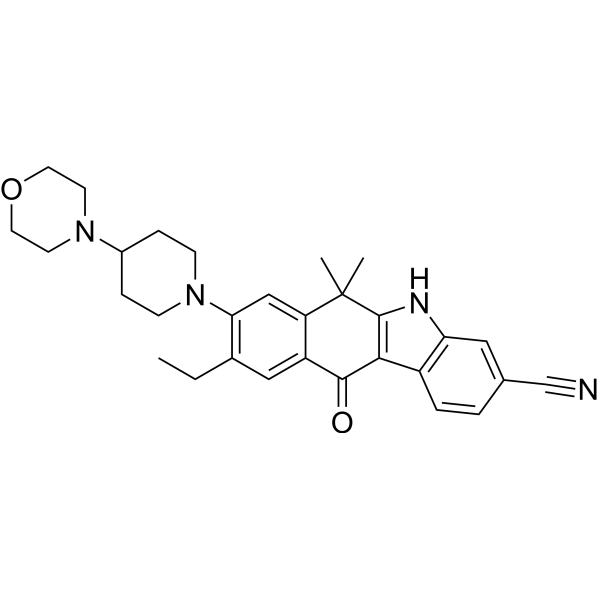Home
Products
Alectinib (CH5424802)



| Product Name | Alectinib (CH5424802) |
| Price: | Inquiry |
| Catalog No.: | CN00460 |
| CAS No.: | 1256580-46-7 |
| Molecular Formula: | C30H34N4O2 |
| Molecular Weight: | 482.62 g/mol |
| Purity: | >=98% |
| Type of Compound: | Alkaloids |
| Physical Desc.: | Powder |
| Source: | |
| Solvent: | Chloroform, Dichloromethane, Ethyl Acetate, DMSO, Acetone, etc. |
| SMILES: | CCc1cc2C(=O)c3c4ccc(cc4[nH]c3C(c2cc1N1CCC(CC1)N1CCOCC1)(C)C)C#N |
| Contact us | |
|---|---|
| First Name: | |
| Last Name: | |
| E-mail: | |
| Question: | |
| Description | Alectinib (CH5424802) is a potent, selective, and orally available ALK inhibitor with an IC50 of 1.9 nM. |
| Target | IC50: 1.9 nM(ALK), 1 nM (ALKF1174L), 3.5 nM (ALKR1275Q)[1] Kd: 2.4 nM (ALK)[1] |
| In Vitro | Alectinib (CH5424802) prevents autophosphorylation of ALK in NCI-H2228 NSCLC cells expressing EML4-ALK, and Alectinib also results in substantial suppression of phosphorylation of STAT3 and AKT, but not of ERK1/2[1]. Alectinib (CH5424802) shows high kinase selectivity and strong anti-proliferative activity against KARPAS-299 with an IC50 value of 3 nM[2]. |
| In Vivo | In the NCI-H2228 model, once-daily oral administration of Alectinib (CH5424802) results in dose-dependent tumor growth inhibition (ED50=0.46 mg/kg) and tumor regression. Treatment of 20 mg/kg Alectinib shows rapid tumor regression (168% tumor growth inhibition; p<0.001), the tumor volume in any mouse is <30 mm3 after 11 days of treatment (at day 28), a potent antitumor effect is maintained, and tumor re-growth dpes not occur throughout the 4-week drug-free period[1]. Oral administration of Alectinib (CH5424802) at 20 mg/kg displays significant tumor regression without body weight loss in an established ALK fusion gene-positive NSCLC xenograft model in mice[2]. Alectinib (Alectinib) at 60 mg/kg causes tumor regression against EML4-ALK-positive NCI-H2228 xenograft model and decreases the levels of phosphorylated ALK in this model. In addition, in mice at dose levels up to 60 mg/kg of CH5424802, there is no body weight loss, no significant change in peripheral blood cell count, no elevations of aspartate aminotransferase or alanine aminotransferase, and no substantial change in electrolytes. Oral administration of CH5424802 at 60 mg/kg for 4 days results in significant tumor regression seen in the luminescence signal[3]. |
| Cell Assay | Cells are cultured in 96-well plates overnight and incubated with various concentrations of Alectinib for the indicated time. For spheroid cell growth inhibition assay, cells are seeded on spheroid plates, incubated overnight, and then treated with Alectinib for the indicated times. The viable cells are measured by the CellTiter-Glo Luminescent Cell Viability Assay. Caspase-3/7 assay is evaluated using the Caspase-Glo 3/7 Assay Kit[1]. |
| Animal Admin | Mice[1] Cell lines are grown as s.c. tumors in SCID or nude mice. Therapeutic experiments are started (day 0) when the tumor reaches ~250 or ~350 mm3. Mice are randomized to treatment groups to receive vehicle or Alectinib (oral, qd) for the indicated duration. Final concentration of vehicle is 0.02 N HCl, 10% DMSO, 10% Cremophor EL, 15% PEG400, and 15% HPCD (2-hydroxypropyl-β-cyclodextrin). The length (L) and width (W) of the tumor mass are measured, and the tumor volume (TV) is calculated as: TV=(L×W2)/2. Tumor growth inhibition is calculated using the following formula: tumor growth inhibition=[1−(T−T0)/(C−C0)]×100. The ED50 is calculated from the values of tumor growth inhibition on the final experimental day. Rats[3] Plasma and brain (cerebrum and cerebellum) samples are prepared at various time points between 4 and 168 h after a single oral administration of 14C-labeled Alectinib (Alectinib) at 1 mg/kg to a rat. The radioactivity concentrations in plasma are determined by a liquid scintillation counter, and the radioactivity concentrations in brain are quantified using quantitative whole-body autography. |
| Density | 1.3±0.1 g/cm3 |
| Boiling Point | 722.5±60.0 °C at 760 mmHg |
| Flash Point | 390.7±32.9 °C |
| Exact Mass | 482.268188 |
| PSA | 72.36000 |
| LogP | 5.48 |
| Vapour Pressure | 0.0±2.3 mmHg at 25°C |
| Storage condition | -20°C |